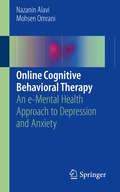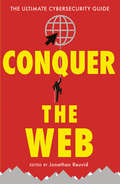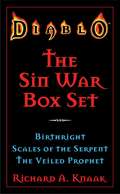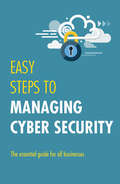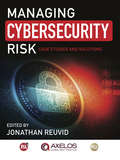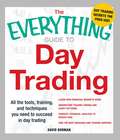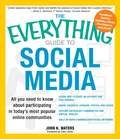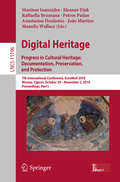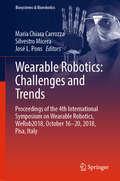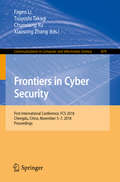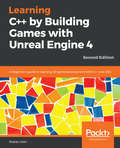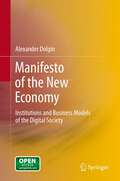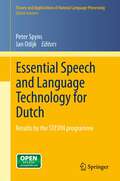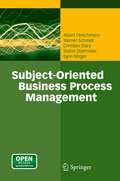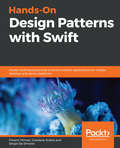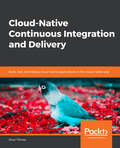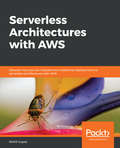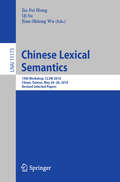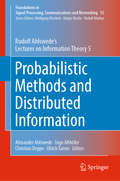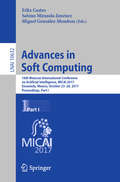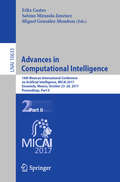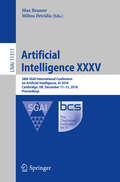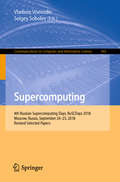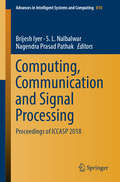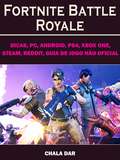- Table View
- List View
Online Cognitive Behavioral Therapy: An E-mental Health Approach to Depression and Anxiety
by Nazanin Alavi Mohsen OmraniThis book aims to provide the clinicians with details of online cognitive behavioral therapy (CBT) to facilitate care delivery for patients struggle with depression and anxiety. Chapters cover some of the most fundamental concepts for successful treatment, including experiments, action plans evidence, and the guidelines for managing, thoughts, feelings, and other key concerns. Designed to be a reader-friendly guide, each chapter opens with a summary of the content and a recap of concepts covered in previous sections, making this highly functional for individual chapter or whole book use. Each chapter also includes recommended tables and chart to facilitate the documentation of each recommended session, making this highly practical resource a vital tool for those who treat patients suffering from these particular mental health concerns.
Conquer the Web: The Ultimate Cybersecurity Guide
by Jonathan Reuvid Nick Wilding Tim Mitchell Maureen Kendal Nick IoannouTons of malicious content floods the internet which can compromise your system and your device, be it your laptop, tablet or phone. <P><P> How often do you make payments online? Do you have children and want to ensure they stay safe online? How often do you sit at a coffee shop and log onto their free WIFI? How often do you use social media on the train or bus? If you believe using an antivirus software will keep devices safe... you are wrong. This book will guide you and provide solutions to avoid common mistakes and to combat cyber attacks. This Guide covers areas such as: <P><P> Building resilience into our IT Lifestyle Online Identity Cyber Abuse: Scenarios and Stories Protecting Devices Download and share Gaming, gamble and travel Copycat websites I Spy and QR Codes Banking, apps and Passwords
Diablo: The Sin War Box Set
by Richard A. KnaakSince the beginning of time, the angelic forces of the High Heavens and the demonic hordes of the Burning Hells have been locked in an eternal conflict for the fate of all Creation. That struggle has now spilled over into Sanctuary -- the world of men. Determined to win mankind over to their respective causes, the forces of good and evil wage a secret war for mortal souls. This is the tale of the Sin War -- the conflict that would forever change the destiny of man. Three thousand years before the darkening of Tristram, Uldyssian, son of Diomedes, was a simple farmer from the village of Seram. Content with his quiet, idyllic life, Uldyssian is shocked as dark events rapidly unfold around him. Mistakenly blamed for the grisly murders of two traveling missionaries, Uldyssian is forced to flee his homeland and set out on a perilous quest to redeem his good name. To his horror, he has begun to manifest strange new powers -- powers no mortal man has ever dreamed of. Now, Uldyssian must grapple with the energies building within him -- lest they consume the last vestiges of his humanity.
Easy Steps to Managing Cybersecurity
by Jonathan ReuvidProviding an insight to the extent and scale a potential damage could cause when there is a breech in cyber security, this guide includes case studies and advice from leading industry professionals, giving you the necessary strategies and resources to prevent, protect and respond to any threat. It covers: Introduction to cyber security, Security framework, Cyber security developments, Routing a map for resilience, Protecting financial data, Countermeasures to advance threats, Managing incidents and breaches, Preparing for further threats, and Updating contingency plans.
Managing Cybersecurity Risk: Cases Studies and Solutions
by Jonathan ReuvidThe first edition, published November 2016, was targeted at the directors and senior managers of SMEs and larger organisations that have not yet paid sufficient attention to cybersecurity and possibly did not appreciate the scale or severity of permanent risk to their businesses. <P><P> The book was an important wake-up call and primer and proved a significant success, including wide global reach and diverse additional use of the chapter content through media outlets. <P><P> The new edition, targeted at a similar readership, will provide more detailed information about the cybersecurity environment and specific threats. It will offer advice on the resources available to build defences and the selection of tools and managed services to achieve enhanced security at acceptable cost. A content sharing partnership has been agreed with major technology provider Alien Vault and the 2017 edition will be a larger book of approximately 250 pages.
The Everything Guide to Day Trading (The Everything®)
by David BormanDay trading can be perilous or profitable--depending upon the expertise of the trader. In this no-nonsense, take-no-prisoners guide, you learn how the market works and how to make it work for you. From screening stocks to conducting technical analyses, you learn everything active traders need to succeed in this tumultuous world, including:What goes on behind the scenes in the marketHow things can go wrong and how to reduce riskWhich kind of technical analyses work--and whyThe best research and trading services to turn to for helpThe ins and outs of chart patterns, like Candlesticks, Triangles, and Head and Shoulders With real-life examples that illustrate the ups and downs inherent in this high-risk, high-profit business, this guide is all you need to trade wisely, quickly, and lucratively, no matter how new you are to the challenging game of day trading.
The Everything Guide to Social Media (The Everything®)
by John K Waters John LesterThe ultimate user's guide to Facebook, Twitter, Flickr, and more!Don't know a tweet from a tweep? Wondering how to get a Second Life? Curious about creating a Facebook profile? Join the social media movement! With The Everything Guide to Social Media, you'll master the lingo, tools, and techniques you need to use all forms of social media. Written in friendly, non-technical language by acclaimed reporter John K. Waters, this highly accessible handbook covers the full range of social media services, including:Messaging and communication (Blogger, Twitter)Communities and social groups (Facebook, MySpace, Friendster)Location-based social networking (Foursquare)News and tagging (Digg, StumbleUpon)Collaboration and cooperation (Wikipedia, Wikispaces)Photos and video sharing (Flickr, YouTube)Opinion and reviews (Yelp, Epinions) With this guide, you'll become comfortable with social media--and learn how to expand your presence online. With a special section on leveraging the power of social networks to build or grow a business, this up-to-the-minute guide is everything you need to walk the talk online--one wiki at a time!
Digital Heritage. Progress in Cultural Heritage: 6th International Conference, Euromed 2016, Nicosia, Cyprus, October 31 - November 5, 2016, Proceedings, Part I (Lecture Notes in Computer Science #10058)
by Marinos Ioannides Eleanor Fink João Martins Raffaella Brumana Petros Patias Anastasios Doulamis Manolis WallaceThis two-volume set LNCS 11196 and LNCS 11197 constitutes the refereed proceedings of the 7th International Conference on Digital Heritage, EuroMed 2018, held in Nicosia, Cyprus, in October/November 2018. The 21 full papers, 47 project papers, and 29 short papers presented were carefully reviewed and selected from 537 submissions. The papers are organized in topical sections on 3D Digitalization, Reconstruction, Modeling, and HBIM; Innovative Technologies in Digital Cultural Heritage; Digital Cultural Heritage –Smart Technologies; The New Era of Museums and Exhibitions; Digital Cultural Heritage Infrastructure; Non Destructive Techniques in Cultural Heritage Conservation; E-Humanities; Reconstructing the Past; Visualization, VR and AR Methods and Applications; Digital Applications for Materials Preservation in Cultural Heritage; and Digital Cultural Heritage Learning and Experiences.
Wearable Robotics: Proceedings of the 4th International Symposium on Wearable Robotics, WeRob2018, October 16-20, 2018, Pisa, Italy (Biosystems & Biorobotics #22)
by José L. Pons Maria Chiara Carrozza Silvestro MiceraThe book reports on advanced topics in the areas of wearable robotics research and practice. It focuses on new technologies, including neural interfaces, soft wearable robots, sensors and actuators technologies, and discusses important regulatory challenges, as well as clinical and ethical issues. Based on the 4th International Symposium on Wearable Robotics, WeRob2018, held October 16-20, 2018, in Pisa, Italy, the book addresses a large audience of academics and professionals working in government, industry, and medical centers, and end-users alike. It provides them with specialized information and with a source of inspiration for new ideas and collaborations. It discusses exemplary case studies highlighting practical challenges related to the implementation of wearable robots in a number of fields. One of the focus is on clinical applications, which was encouraged by the colocation of WeRob2018 with the International Conference on Neurorehabilitation, INCR2018. Additional topics include space applications and assistive technologies in the industry. The book merges together the engineering, medical, ethical and political perspectives, thus offering a multidisciplinary, timely snapshot of the field of wearable technologies.
Frontiers in Cyber Security: First International Conference, FCS 2018, Chengdu, China, November 5-7, 2018, Proceedings (Communications in Computer and Information Science #879)
by Tsuyoshi Takagi Fagen Li Chunxiang Xu Xiaosong ZhangThis book constitutes the proceedings of the First International Conference on Frontiers in Cyber Security, held in Chengdu, China, in November 2018. The 18 full papers along with the3 short papers presented were carefully reviewed and selected from 62 submissions. The papers are organized in topical sections, namely: symmetric key cryptography, public key cryptography, post-quantum cryptography, cloud security and data deduplication, access control, attack and behavior detection, system and network security, security design.
Learning C++ by Creating Games with Unreal Engine 4 - Second Edition
by Sharan VolinIf you are really passionate about games and have always wanted to write your own, this book is perfect for you. It will help you get started with programming in C++ and explore the immense functionalities of UE4
Manifesto of the New Economy: Institutions and Business Models of the Digital Society
by Alexander DolginThe book describes the main directions for the development of the digital society. The author angles its book to those who are interested to know what would replace search engines, and how social networks would evolve; what profit can be made of different forms of informational collaboration (crowdsourcing, collaborative filtering). And, the main thing, how it will influence the structure of the society and human pursuit for happiness. The author does not confine himself to a theory, he sets and solves practical questions: How talent, success and "stardom" are interconnected, how to make money in social networks, what is the business model for the development of entertainment and media, how to measure cultural values, and what is the subjective time of the individual and how to make it qualitative? There have been no answers to these questions before. Internet and social networks have provided tools and data that Alexander Dolgin was the first to use in economics.
Essential Speech and Language Technology for Dutch: Results by the STEVIN-programme (Theory and Applications of Natural Language Processing #14)
by Peter Spyns Linde Van Bosch Jan OdijkThe book provides an overview of more than a decade of joint R&D efforts in the Low Countries on HLT for Dutch. It not only presents the state of the art of HLT for Dutch in the areas covered, but, even more importantly, a description of the resources (data and tools) for Dutch that have been created are now available for both academia and industry worldwide. The contributions cover many areas of human language technology (for Dutch): corpus collection (including IPR issues) and building (in particular one corpus aiming at a collection of 500M word tokens), lexicology, anaphora resolution, a semantic network, parsing technology, speech recognition, machine translation, text (summaries) generation, web mining, information extraction, and text to speech to name the most important ones. The book also shows how a medium-sized language community (spanning two territories) can create a digital language infrastructure (resources, tools, etc.) as a basis for subsequent R&D. At the same time, it bundles contributions of almost all the HLT research groups in Flanders and the Netherlands, hence offers a view of their recent research activities. Targeted readers are mainly researchers in human language technology, in particular those focusing on Dutch. It concerns researchers active in larger networks such as the CLARIN, META-NET, FLaReNet and participating in conferences such as ACL, EACL, NAACL, COLING, RANLP, CICling, LREC, CLIN and DIR ( both in the Low Countries), InterSpeech, ASRU, ICASSP, ISCA, EUSIPCO, CLEF, TREC, etc. In addition, some chapters are interesting for human language technology policy makers and even for science policy makers in general.
Subject-Oriented Business Process Management: Second International Conference, S-bpm One 2010, Karlsruhe, Germany, October 14, 2010 Selected Papers (Communications In Computer And Information Science #138)
by Werner Schmidt Albert Fleischmann Christian Stary Egon Börger Stefan ObermeierActivities performed in organizations are coordinated via communication between the people involved. The sentences used to communicate are naturally structured by subject, verb, and object. The subject describes the actor, the verb the action and the object what is affected by the action. Subject-oriented Business Process Management (S-BPM) as presented in this book is based on this simple structure which enables process-oriented thinking and process modeling. S-BPM puts the subject of a process at the center of attention and thus deals with business processes and their organizational environment from a new perspective, meeting organizational requirements in a much better way than traditional approaches. Subjects represent agents of an action in a process, which can be either technical or human (e.g. a thread in an IT system or a clerk). A process structures the actions of each subject and coordinates the required communication among the subjects. S-BPM provides a coherent procedural framework to model and analyze business processes: its focus is the cooperation of all stakeholders involved in the strategic, tactical, and operational issues, sharing their knowledge in a networked structure. The authors illustrate how each modeling activity through the whole development lifecycle can be supported through the use of appropriate software tools. The presentation style focuses on professionals in industry, and on students specializing in process management or organizational modeling. Each chapter begins with a summary of key findings and is full of examples, hints, and possible pitfalls. An interpreter model, a toolbox, and a glossary summarizing the main terms complete the book. The web site www.i2pm.net provides additional software tools and further material.
Hands-On Design Patterns with Swift: Master Swift Best Practices To Build Modular Applications For Mobile, Desktop, And Server Platforms
by Florent VilmartThis book is for intermediate developers who want to apply design patterns with Swift to structure and scale their applications. You are expected to have basic knowledge of iOS and Swift.
Cloud-Native Continuous Integration and Delivery: Build, Test, And Deploy Cloud-native Applications In The Cloud-native Way
by Onur YilmazThis course is ideal for professionals interested in cloud-native software development. To benefit the most from this course, you must be familiar with developing, building, testing, integrating, and deploying containerized microservices into cloud systems.
Serverless Architectures with AWS: Discover How You Can Migrate From Traditional Deployments To Serverless Architectures With Aws
by Mohit GuptaNo AWS experience is assumed but the book is targeted to technical professionals. Examples will be provided using Java or Node.js but AWS provides SDKs for other programming languages, including Python and .NET. These languages are supported by the AWS Lambda functions too.
Chinese Lexical Semantics: 19th Workshop, CLSW 2018, Chiayi, Taiwan, May 26–28, 2018, Revised Selected Papers (Lecture Notes in Computer Science #11173)
by Jia-Fei Hong Qi Su Jiun-Shiung WuThis book constitutes the thoroughly refereed post-workshop proceedings of the 19th Chinese Lexical Semantics Workshop, CLSW 2018, held in Chiayi, Taiwan, in May 2018. The 50 full papers and 19 short papers included in this volume were carefully reviewed and selected from 150 submissions. They are organized in the following topical sections: Lexical Semantics; Applications of Natural Language Processing; Lexical Resources; Corpus Linguistics.
Probabilistic Methods and Distributed Information: Rudolf Ahlswede’s Lectures on Information Theory 5 (Foundations in Signal Processing, Communications and Networking #15)
by Holger Boche Ingo Althöfer Christian Deppe Ulrich Tamm Alexander Ahlswede Rudolf Ahlswede Vladimir Blinovsky Ulrich Krengel Ahmed MansourThe fifth volume of Rudolf Ahlswede’s lectures on Information Theory focuses on several problems that were at the heart of a lot of his research. One of the highlights of the entire lecture note series is surely Part I of this volume on arbitrarily varying channels (AVC), a subject in which Ahlswede was probably the world's leading expert. Appended to Part I is a survey by Holger Boche and Ahmed Mansour on recent results concerning AVC and arbitrarily varying wiretap channels (AVWC). After a short Part II on continuous data compression, Part III, the longest part of the book, is devoted to distributed information. This Part includes discussions on a variety of related topics; among them let us emphasize two which are famously associated with Ahlswede: "multiple descriptions", on which he produced some of the best research worldwide, and "network coding", which had Ahlswede among the authors of its pioneering paper. The final Part IV on "Statistical Inference under Communication constraints" is mainly based on Ahlswede’s joint paper with Imre Csiszar, which received the Best Paper Award of the IEEE Information Theory Society. The lectures presented in this work, which consists of 10 volumes, are suitable for graduate students in Mathematics, and also for those working in Theoretical Computer Science, Physics, and Electrical Engineering with a background in basic Mathematics. The lectures can be used either as the basis for courses or to supplement them in many ways. Ph.D. students will also find research problems, often with conjectures, that offer potential subjects for a thesis. More advanced researchers may find questions which form the basis of entire research programs.
Advances in Soft Computing: 16th Mexican International Conference on Artificial Intelligence, MICAI 2017, Enseneda, Mexico, October 23-28, 2017, Proceedings, Part I (Lecture Notes in Computer Science #10632)
by Sabino Miranda-Jiménez Félix Castro Miguel González-MendozaThe two-volume set LNAI 10632 and 10633 constitutes the proceedings of the 16th Mexican International Conference on Artificial Intelligence, MICAI 2017, held in Enseneda, Mexico, in October 2017. The total of 60 papers presented in these two volumes was carefully reviewed and selected from 203 submissions. The contributions were organized in the following topical sections: Part I: neural networks; evolutionary algorithms and optimization; hybrid intelligent systems and fuzzy logic; and machine learning and data mining. Part II: natural language processing and social networks; intelligent tutoring systems and educational applications; and image processing and pattern recognition.
Advances in Computational Intelligence: 16th Mexican International Conference on Artificial Intelligence, MICAI 2017, Enseneda, Mexico, October 23-28, 2017, Proceedings, Part II (Lecture Notes in Computer Science #10633)
by Sabino Miranda-Jiménez Félix Castro Miguel González-MendozaThe two-volume set LNAI 10632 and 10633 constitutes the proceedings of the 16th Mexican International Conference on Artificial Intelligence, MICAI 2017, held in Enseneda, Mexico, in October 2017. The total of 60 papers presented in these two volumes was carefully reviewed and selected from 203 submissions. The contributions were organized in the following topical sections: Part I: neural networks; evolutionary algorithms and optimization; hybrid intelligent systems and fuzzy logic; and machine learning and data mining. Part II: natural language processing and social networks; intelligent tutoring systems and educational applications; and image processing and pattern recognition.
Artificial Intelligence XXXV: 38th SGAI International Conference on Artificial Intelligence, AI 2018, Cambridge, UK, December 11–13, 2018, Proceedings (Lecture Notes in Computer Science #11311)
by Max Bramer Miltos PetridisThis book constitutes the proceedings of the 38th SGAI International Conference on Innovative Techniques and Applications of Artificial Intelligence, AI 2018, held in Cambridge, UK, in December 2018. The 25 full papers and 12 short papers presented in this volume were carefully reviewed and selected from 46 submissions. There are technical and application papers which were organized in topical sections named: Neural Networks; Planning and Scheduling; Machine Learning; Industrial Applications of Artificial Intelligence; Planning and Scheduling in Action; Machine Learning in Action; Applications of Machine Learning; and Applications of Agent Systems and Genetic Algorithms.
Supercomputing: 4th Russian Supercomputing Days, RuSCDays 2018, Moscow, Russia, September 24–25, 2018, Revised Selected Papers (Communications in Computer and Information Science #965)
by Vladimir Voevodin Sergey SobolevThis book constitutes the refereed proceedings of the 4th Russian Supercomputing Days, RuSCDays 2018, held in Moscow, Russia, in September 2018.The 59 revised full papers and one revised short paper presented were carefully reviewed and selected from 136 submissions. The papers are organized in topical sections on parallel algorithms; supercomputer simulation; high performance architectures, tools and technologies.
Computing, Communication and Signal Processing: Proceedings Of Iccasp 2018 (Advances In Intelligent Systems and Computing #810)
by Brijesh Iyer S. L. Nalbalwar Nagendra Prasad PathakThis book highlights cutting-edge research on various aspects of human–computer interaction (HCI). It includes selected research papers presented at the Third International Conference on Computing, Communication and Signal Processing (ICCASP 2018), organized by Dr. Babasaheb Ambedkar Technological University in Lonere-Raigad, India on January 26–27, 2018. It covers pioneering topics in the field of computer, electrical, and electronics engineering, e.g. signal and image processing, RF and microwave engineering, and emerging technologies such as IoT, cloud computing, HCI, and green computing. As such, the book offers a valuable guide for all scientists, engineers and research students in the areas of engineering and technology.
Fortnite Battle Royale, Dicas, PC, Android, PS4, Xbox One, Steam, Reddit, Guia de Jogo não Oficial
by The YuwQueres dominar o jogo e os teus oponentes? Tens dificuldades em recolher recursos? Queres os melhores itens? Queres saber como transferir e instalar o jogo? Se sim, então estamos aqui para ti. Vamos guiar-te pelo jogo, partilhar os truques e estratégias dos profissionais, e contar-te os segredos do jogo. O que vais encontrar neste livro: - Como transferir e instalar o jogo. - Dicas e estratégias dos profissionais. - Truques. - Zonas de Aterragem. - Armas. - Trackers. - Como ganhar um combate! - Como Dominar o Multiplayer! - Combate e Movimento. - Construções. - Segredos, Dicas, Truques, Unlockables, e os Truques usados pelos Pros! - Como apanhar montes de recursos. - E MUITO MAIS! Então, de que estás á espera? Assim que agarrares uma cópia do nosso guia vais começar a dominar o jogo em menos de nada! Agarra já as tuas pro tips.
